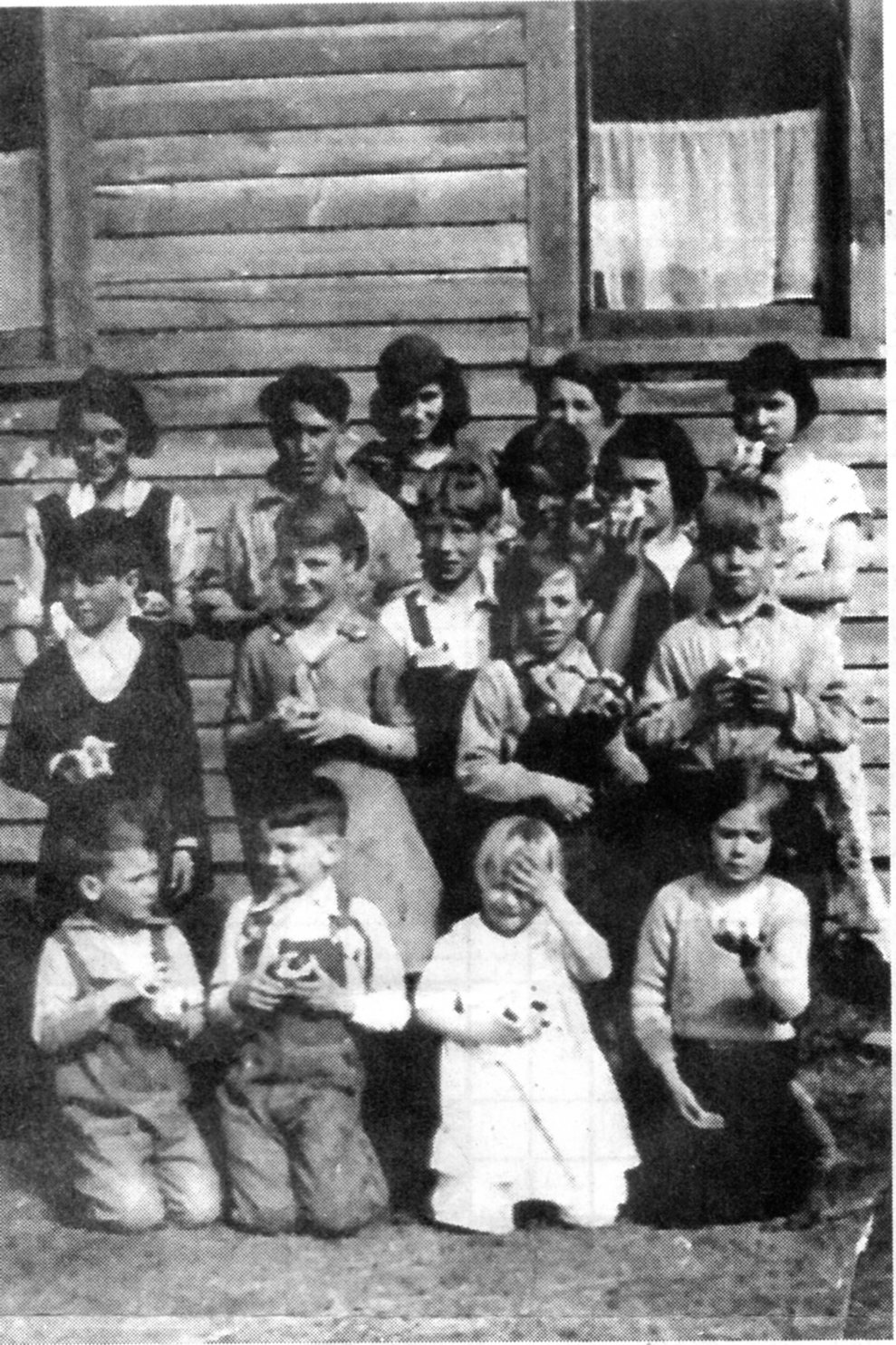
LaFond or Wickersham School
Submitted by Nute Chapman
From Onaway Outlook October 25, 2013

 |
LaFond or Wickersham School Submitted by Nute Chapman From Onaway Outlook October 25, 2013 |
 |
CAPTION: STUDENTS AT THE LaFond or Wickersham School: Back from left, unknown, Lyle Camp, teacher Mary Ennes,
Lois (Wickersham) Johnson, a mother of two of the students, unknown, Annie Morgan. Middle from left, Louie Lietart,
Freda (Wickersham) Tucker, Walter Ours, Billy Morgan and Kenneth Woods. Front from left: unknown, Marlon LaFond,
Doris Ours and Rita (Lietart) Vargason.
 The first site for the LaFond School was on the south side of what is now called Tucker Road approximately three-tenths
of a mile west of Centerline Road on a portion of the Doug Paulus property, where fruit trees are now planted. In the
early years of this century, there was a road used during the lumbering days that ran north and south through that area
of the township. There is no longer any sign of a road. The Dickerson Lumber Camp would have been to the north of that
spot about one mile, while to the south there had been another lumber camp.
The first site for the LaFond School was on the south side of what is now called Tucker Road approximately three-tenths
of a mile west of Centerline Road on a portion of the Doug Paulus property, where fruit trees are now planted. In the
early years of this century, there was a road used during the lumbering days that ran north and south through that area
of the township. There is no longer any sign of a road. The Dickerson Lumber Camp would have been to the north of that
spot about one mile, while to the south there had been another lumber camp.
The school had been named for the LaFond Family who were early settlers in that area. This was a log cabin building,
which was replaced by a frame building at another site.
In July of 1908, Isaac Erratt and Daniel Pollack were asked to look over a new school site for LaFond School, District
Number 6 of Forest Township.
The new schoolhouse was then built on the southeast corner of Tucker and Centerline Roads east of the Roy Wickersham
property. Valerie Lietart remembers as a youth, of their cows being kept in the old abandoned schoolhouse across the
road from their farm. The newer LaFond School was in service from 1909 through the school term ending in 1915.
The building then remained unused as a school for many years when most of the early settlers had moved away.
The remaining few stayed on to pursue farming. Their children were transported to the Tower School.
That was no easy task in winter and early spring with horsedrawn sleigh or wagon. By 1933, people had begun to
resettle in the area when the Depression years brought people back to the land from the cities where there were no
jobs to be found. Some of the land was then homesteaded. There were enough families with children to warrant reopening
the school that had been vacant for over 20 years.
During those years the building had been used for occasional dances, but no upkeep had taken place or any painting.
To make it ready for reopening as a school, one end of the room was partitioned off with rough-sawn boards to create a
place to store wood behind the partition. The schoolroom side of the partition had a rolldown black board similar to
the large black widow shade. It was quite a feat to write on the makeshift blackboard and avoid hitting the cracks in
the uneven boards behind it and breaking the chalk. The school by this time in 1933 was called the Wickersham School
since it was near the home of Roy and Lena Wickersham. With reopening it was lacking most of the necessities. Water
had to be carried in a pail from the Wickersham pump so it was used sparingly. Books had to be gathered from other
schools in the township that could be spared. Quite often they were without covers and pages missing.
Teachers’ wages that year had hit a new low of $25 per month. At the end of the school year, money had come on from
swamp tax refund from the state so each teacher received $180 bonus, making the equivalent of $45 per month for the year
in the township.
There were no frills to be had during those deep Depression times and food was scarce in many of the lunch pails.
An orange would have been an unheard of treat. But out of the hard times shared by the few children attending school,
there was a special bond of caring and appreciation for things too often overlooked in today’s world of plenty and over
indulgence.
Christmas and Easter held special memories. With Christmas programs, popcorn popped over the coals in the wood-burning
stove, and there were boxes of candy and nuts for the children.
At Easter they were able to be in a real egg hunt when Mr. Wickersham asked if they might help find a nest of one of
his hen turkeys that had hidden in the woods. They finally spied the hen with her hidden nest in the brush by a creek
nearby. Then of course they had colored eggs to find in the stumps and hiding places near the school. Happiness was
not counted in material things.
The school continued to be in use until 1941 when the country schools were discontinued and students went to Tower
or Onaway.
The building was purchased by Ray Tucker to be used as a tool shed on his farm. The school bell was donated to the
drive for scrap metal for World War II, according to the widow Mrs. Edra (Wickersham) Tucker.
From the Onaway Outlook, October 25, 2013, p. 10
Retyped by J. Anderson.